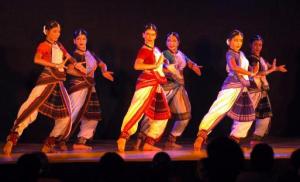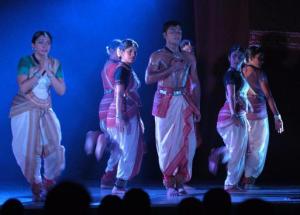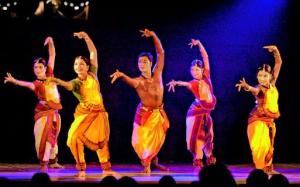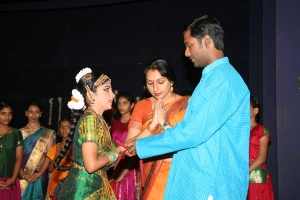
by Samanth Subramanian
Narendra does – emphatically. One hour before a show, he hasn’t even entered the green room. He still stands on stage, producer-director-choreographer-dancer merged into one, deciding where the smoke machines should go, cueing music for last-minute rehearsals, watching moves out of the corner of his eye even as he speaks to the light-and-sound men, nudging members of his troupe Anusham to get dressed, worrying about the feeble voltage, limbering up almost unconsciously himself.
He’s also fretting silently. “Only yesterday, we found out that we were required to perform for two hours. We’ve been rehearsing a one-hour show for three weeks now,” he says. For three weeks of practice, three or more hours a day, the payoff isn’t spectacular; Anusham will get Rs 8,000, and after paying for lights and costumes, Narendra will be left with Rs 1,500. “I still try to pay my dancers, even if it isn’t a grand amount,” he says. “They’ve paid for autos and buses to come every evening to rehearse, so it’s only right that they get something in return.”
WALK OF LIFE
When he was learning to dance himself, Narendra took no autos or buses. Living in a flat the size of a matchbox, with both his brother and father out of work, Narendra had just passed out of school when he enrolled to study under the renowned VP Dhananjayan. His interest in dance was almost congenital; even before the age of five, when he heard music, he would involuntarily move to its rhythm. When he then began taking classes, he was further drawn to the grace and beauty of Bharatanatyam.
“When I started learning under Dhananjayan sir, financially we were in a very sad situation. So I walked to dance class,” he says – from Villivakkam to Adyar, six days a week, three and a half hours every morning and three and a half hours every evening, with eight hours of dance in between. On the seventh day, he hardly rested; without the knowledge of the other students, he crept into the classroom to clean and mop the floor. “Dance was my life. I would have done anything for it.”
It is the sort of situation, says 30-year-old Narendra, that many young male dancers find themselves in now. “Today, men from the middle- and upper middle-class take up dance just as a hobby, and they get into other, more lucrative careers,” he says. “Almost all the really committed, disciplined male dancers come from poor backgrounds, with fewer educational and professional options in front of them. They’re the ones who have the fire in the belly, the passion.”
Dhananjayan has noticed a similar demographic shift. Long acclaimed as the man who put masculinity back into male Bharatanatyam, he began his own career in straitened circumstances, and he knows what he’s seeing. “It’s all thanks to the economic renaissance,” he says. “Earlier, in Kerala for example, even the rich Namboodris used to seriously pursue Kathakali.” Today, though, there are suddenly professions out there that can pay – literally – a thousand times better, so only the educationally and financially disadvantaged look to dance to haul themselves upwards.
J Guru Prasad and J Krishna Kumar – unrelated, shared initial notwithstanding – illustrate that well. With an ancestral phalanx of chartered accountants behind him, Guru Prasad never once entertained the idea of dancing as a career, even though he learned the art for 15 years. “The CA was always my goal,” he says. “Dance had much less career security, and by the time I was even aware that it was a possible profession, I was 24 or 25. Much too late to start then.”
Krishna Kumar, from the village of Chinnamanoor in Tamil Nadu, took the road less travelled. His father refused to support his dance lessons, so he worked as an attendant at a hospital to pay his fees. “I carted boxes, handed out injections, did odd jobs. Out of the Rs 250 I earned every month, I paid Rs 200 for dance tuitions,” he says. When he read about the Kalakshetra dance academy in Chennai, he performed a different type of penance every day – “hunger one day, standing in the sun the next, and so on” – until his parents relented and allowed him to join.
DIRE STRAITS
When he emerged from Kalakshetra four years later, though, Krishna Kumar drew a blank. Even today, decades after Dhananjayan burst onto the scene, it is difficult for male dancers to forge solo careers. “It is the same with classical dance everywhere,” says Dhananjayan. “Earlier we had great male artistes like Uday Shankar, Ram Gopal, Govinda Gopal and Guru Gopinath, but with the exception of Gopinath, all the rest had to establish themselves abroad first.” Despite his own successes, Dhananjayan says, “Bharatanatyam is still regarded by many as a female art.”
That is not necessarily the case elsewhere in India. Leela Samson, the current director of Kalakshetra and a dancer who has worked all over the country, points to Manipuri, Kathakali and Kathak as examples of dances that are dominated by men. Even in Bharatanatyam, she says, the men don’t need to get disheartened. “Look at Kelucharan Mahapatra. He revived Odissi, but only towards the tail end of his career, when he was 55 or so, was he recognised as an amazing performer,” she says. “It didn’t worry him, and it shouldn’t worry the current batch. In fact, we have it better in India; elsewhere in the world, ballet dancers are struggling to even survive. Dance may be a particularly tough field, but it all depends on the work you do.”
Even if there are more difficulties today, Dhananjayan won’t agree that his generation had it significantly easier. “There are other avenues to explore now,” he says. “There are more companies willing to come forward as sponsors; there are more parents who want their children to learn.” MV Narasimhachari, president of the Association of Bharatanatyam Artistes of India (ABHAI) and a contemporary of Dhananjayan, cites exactly those two routes to a sustainable dance career. “They simply must learn, along with the art, how to promote themselves well.”
Narendra took one of those two routes. When he isn’t rehearsing classical Bharatanatyam, he stages shows for corporate events, incorporating athletic arts like Kalaripayattu and using lighter, livelier music. “When I had to add another hour to this show, I was forced to bring in some of those numbers,” he says almost regretfully. And yet these corporate events put food on the table and money into his dancers’ pockets, and Narendra realises it.
When he hears that Dhananjayan has extolled today’s plentiful opportunities, he smiles wanly, and like a good shishya, he does not contradict his guru directly. Instead, almost gently, he says: “I know many male dancers who cannot even eat three meals a day.” He points to one of his own dancers practicing off to one side of the rehearsal space. Thiruchelvan came to Chennai from Sri Lanka just to learn dance, and Narendra says he survives solely on passion.
A little further up the ladder are the overseas tours, but far from being extravagant junkets, they are compressed capsules of maddeningly hard work. “On an upcoming tour, travelling all the while, we are going to be doing 10 shows in the first 10 days,” says Narendra. It will be his 15th trip to the US in almost as many years. For those three months of touring, he points out, lapsing again into the comparative ratio, there needs to be one year of preparation. “So even if we do earn $5,000 at the end of it all, that’s actually for 15 months of work, not three.”
SO FAR AWAY
Fresh out of Kalakshetra, Krishna Kumar heard about a teaching position at a school in Vellore, and with little else on hand, he accepted it. Ten years later, he’s still at it; every weekend, he travels to Vellore to tutor a student body that has grown to a strength of 100. Like Narendra, he is proof that it is possible to survive – just about – in this profession. “I came to Chennai to be a big dancer,” says Krishna Kumar. “But when I had to struggle to make ends meet, I had to accept it. That desire is still there, but when you realise that you just cannot become big, you have to live with that fact.”
Narasimhachari won’t have any of it. “They should stop complaining,” he says; there’s a smile on his face, but his voice is stern. “There is too much of a hunger for opportunities today, and too much complaining if they don’t come along. People are always looking for the next chance to go to London or America, when they should really be working harder on their art. If you get to a certain level of excellence, merit will tell. Talent will tell.”
He admits, though, that audiences are dwindling; even for his performances, well known as he is, he says he can’t pack the halls. At Narendra’s show, the auditorium is barely two-thirds full. The performance wends a smooth enough way to its conclusion. The first half, a package titled Shakti, is admirably creative and admirably danced. The second half, even if it isn’t marred by glaring missteps, looks exactly like what it is – a hastily tacked-on 60 minutes, completely divergent in tone and appeal from what came before.
To the smattering of audience that drifts backstage to congratulate the dancers, Narendra is his usual genial, slightly shy self. His torso is still slick with sweat, and he hasn’t yet changed out of his costume. He will leave the venue only an hour later, after reverting to his producer-director self, supervising packing up, settling dues, making sure the girls have rides home, making sure nothing is left behind in the green rooms. Then he will get on his bike, richer by Rs 1,500, and drive back home. He lives for what he does, though, and he doesn’t have to walk 25 kilometers home every day. Perhaps there’s something to be said for that.



